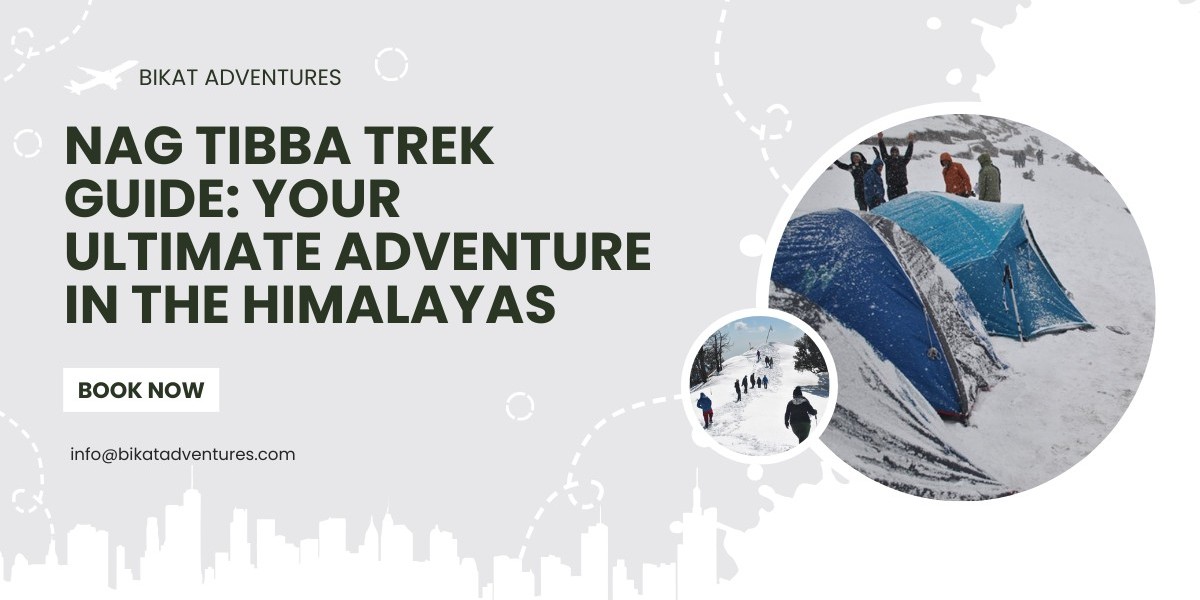Introduction
Nestled in the Garhwal region of Uttarakhand, the Nag Tibba Trek is a perfect blend of adventure, scenic beauty, and cultural richness. Known as the "Serpent’s Peak," Nag Tibba offers an exhilarating experience that caters to both novice trekkers and seasoned hikers. This guide will provide you with everything you need to know about the Nag Tibba Trek, from preparation and routes to the mesmerizing sights you'll encounter along the way.
Why Choose the Nag Tibba Trek?
Accessible Yet Adventurous
One of the key reasons the Nag Tibba Trek stands out is its accessibility. Located near Mussoorie, it’s a convenient option for those looking to escape the hustle and bustle of city life without embarking on a long and strenuous journey. Despite being an easy-to-moderate trek, Nag Tibba does not compromise on the adventure quotient. The trail offers a mix of dense forests, open meadows, and challenging ascents, all culminating in a breathtaking summit that rewards trekkers with panoramic views of the Himalayas.
Ideal for All Seasons
Another compelling aspect of the Nag Tibba Trek is its year-round accessibility. Whether you’re trekking in the spring, when the landscape is lush and green, or during the winter, when the trail is blanketed in snow, Nag Tibba offers a unique experience in every season. For those seeking a snow trek, the winter months (November to March) are ideal. Spring and summer (April to June) provide pleasant weather and clear skies, perfect for capturing stunning photographs of the surrounding peaks.
Planning Your Nag Tibba Trek
How to Reach Nag Tibba
By Air
The nearest airport to Nag Tibba is the Jolly Grant Airport in Dehradun, approximately 85 km from Pantwari, the base village for the trek. From the airport, you can hire a taxi or take a bus to reach Pantwari.
By Train
Dehradun is the nearest railway station, well-connected to major cities across India. From Dehradun, Pantwari is about 60 km, and you can reach the village by hiring a taxi or taking a local bus.
By Road
Pantwari is easily accessible by road from Dehradun, Mussoorie, and other nearby towns. Regular buses and taxis are available from Dehradun and Mussoorie, making it convenient to reach the base village.
Trekking Route Overview
The Nag Tibba Trek begins at Pantwari, a quaint village that serves as the starting point for the adventure. The entire trek can be completed in two days, making it an ideal weekend getaway. Here’s a day-wise breakdown of the trek:
Day 1: Pantwari to Nag Tibba Base Camp
- Distance: 6-7 km
- Duration: 4-5 hours
- Altitude Gain: 1,400 meters to 2,600 meters
The first day of the trek starts from Pantwari village and takes you through beautiful terraced fields and oak forests. As you ascend, the trail becomes steeper, but the surrounding views of the Garhwal mountains keep your spirits high. After a few hours of trekking, you’ll reach Nag Tibba Base Camp, where you can set up camp for the night. The campsite offers stunning views of the snow-capped peaks and is an ideal spot to relax and soak in the beauty of the Himalayas.
Day 2: Nag Tibba Base Camp to Nag Tibba Summit and Return to Pantwari
- Distance: 10 km (round trip)
- Duration: 6-7 hours
- Altitude Gain: 2,600 meters to 3,022 meters
On the second day, you’ll start early to reach the Nag Tibba summit. The trail is relatively steep but manageable, taking you through dense forests and open meadows. As you approach the summit, the views become more and more spectacular. Upon reaching the summit, you’ll be greeted by a 360-degree panoramic view of the Himalayas, including prominent peaks like Bandarpoonch, Kedarnath, and Gangotri. After spending some time at the summit, you’ll begin your descent back to Pantwari, completing the trek.
What to Expect on the Nag Tibba Trek
Stunning Views
One of the main attractions of the Nag Tibba Trek is the unparalleled views it offers. From the summit, you can enjoy a panoramic vista of some of the most famous Himalayan peaks, including:
- Bandarpoonch: A prominent peak in the Garhwal region, Bandarpoonch stands at 6,316 meters and is known for its striking resemblance to a monkey’s tail.
- Kedarnath Peak: Part of the greater Kedarnath range, this peak is a favorite among trekkers and mountaineers alike.
- Swargarohini: This peak is associated with the legendary ascent to heaven by the Pandavas in the Indian epic, Mahabharata.
- Gangotri Peaks: These peaks are part of the Gangotri glacier, one of the primary sources of the Ganges River.
Diverse Flora and Fauna
The Nag Tibba Trek takes you through a variety of landscapes, from dense oak and rhododendron forests to open meadows and rocky outcrops. The trek is also home to diverse flora and fauna, making it a treat for nature lovers. Keep an eye out for Himalayan birds, wildflowers, and, if you’re lucky, you might even spot a barking deer or a Himalayan black bear.
Cultural Insights
The trek also offers a glimpse into the local culture and lifestyle of the Garhwali people. As you pass through small villages, you’ll get a chance to interact with the locals and learn about their traditions, farming practices, and day-to-day life in the mountains.
Essential Gear and Packing List for Nag Tibba Trek
Clothing
- Layers: The weather in the mountains can be unpredictable, so it’s essential to dress in layers. Pack thermal wear, a fleece jacket, a windproof jacket, and a down jacket for the nights.
- Trekking Pants: Comfortable and quick-drying pants are a must.
- Rain Gear: A good-quality rain jacket and pants are essential, especially during the monsoon season.
- Trekking Shoes: Invest in a pair of sturdy, waterproof trekking shoes with good grip.
Camping Equipment
- Tent: If you’re camping on your own, bring a lightweight, weather-resistant tent.
- Sleeping Bag: A sleeping bag rated for sub-zero temperatures is recommended.
- Sleeping Mat: A foam or inflatable mat will provide insulation and comfort.
Accessories
- Backpack: A 40-50 liter backpack with a rain cover is ideal.
- Headlamp: A headlamp with extra batteries is essential for night trekking or camping.
- Water Bottle: Carry at least two liters of water and a reusable bottle.
- Trekking Poles: These can be very helpful on steep sections of the trek.
First Aid and Essentials
- First Aid Kit: Include basic medicines, band-aids, antiseptic cream, and any personal medications.
- Sunscreen and Lip Balm: Protect your skin from the harsh sun at high altitudes.
- Snacks: Carry energy bars, dry fruits, and chocolates for quick energy boosts.
- Camera: Don’t forget to capture the stunning landscapes and memories.
Best Time to Visit Nag Tibba Trek
Winter Trekking (November to March)
If you’re looking for a snow adventure, the winter months are the best time to visit Nag Tibba. The trail is covered in a thick layer of snow, transforming the landscape into a winter wonderland. The temperatures can drop significantly, so be prepared for cold weather trekking.
Summer and Spring Trekking (April to June)
The spring and early summer months are ideal for those who prefer milder weather. The landscape is lush and green, with wildflowers in full bloom. This is also the best time for photography, as the skies are clear, offering unobstructed views of the surrounding peaks.
Monsoon Trekking (July to September)
While the Nag Tibba Trek is accessible during the monsoon season, the trail can be slippery and challenging due to heavy rains. However, if you don’t mind a bit of rain, the monsoon offers a different kind of beauty, with the entire region draped in mist and greenery.
Safety Tips and Guidelines for Nag Tibba Trek
Acclimatization
Although the Nag Tibba Trek is relatively short, it’s still important to acclimatize properly, especially if you’re coming from lower altitudes. Take it slow, stay hydrated, and listen to your body.
Hydration
Staying hydrated is crucial at high altitudes. Make sure to drink plenty of water throughout the trek, even if you don’t feel thirsty.
Weather Conditions
Always check the weather forecast before starting the trek. Mountain weather can change rapidly, so be prepared for sudden rain, snow, or temperature drops.
Trekking with a Guide
If you’re new to trekking or unfamiliar with the region, it’s advisable to hire a local guide. They can provide valuable insights, ensure your safety, and enhance your overall trekking experience.
Conclusion
The Nag Tibba Trek is a must-do for anyone seeking a quick yet fulfilling adventure in the Himalayas. With its diverse landscapes, stunning views, and cultural richness, Nag Tibba offers an experience that is both exhilarating and soul-soothing. Whether you’re a seasoned trekker or a first-timer, this trek promises to leave you with memories that will last a lifetime. So pack your bags, lace up your trekking boots, and get ready to embark on the ultimate Himalayan adventure!






